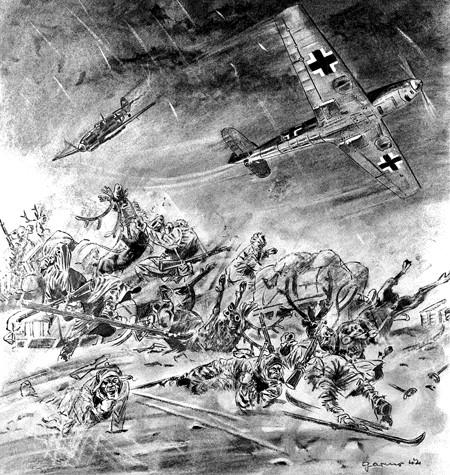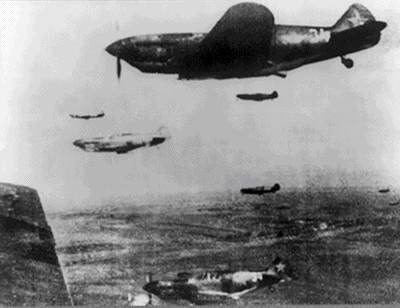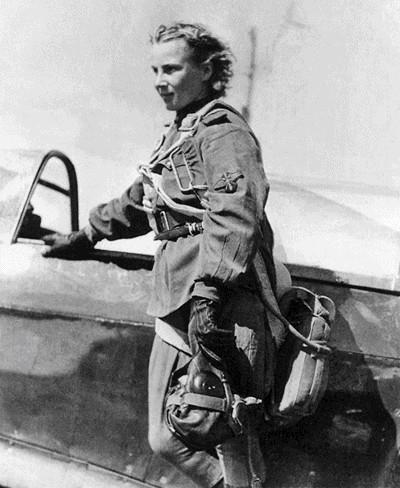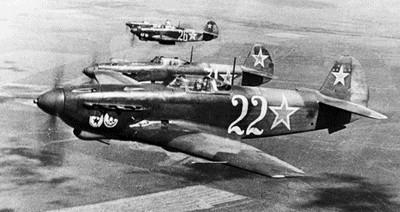Lords of the Sky: Fighter Pilots and Air Combat, From the Red Baron to the F-16 (49 page)
Read Lords of the Sky: Fighter Pilots and Air Combat, From the Red Baron to the F-16 Online
Authors: Dan Hampton
Tags: #History, #United States, #General, #Military, #Aviation, #21st Century

Shortly after midnight the attack began with airborne drops and glider assaults on the flank areas of the beaches. The British 6th Airborne was to seize bridges over the rivers Orne and Dives, while the U.S. 101st and 82nd Airborne took the neck of the Cotentin Peninsula. Unfortunately for the Americans, many of their glider pilots either panicked at the flak or landed their tows in the wrong drop zones. Despite high casualties, the survivors banded together where they could and created incredible confusion behind the German lines.
At 6:30 more than 150,000 Allied soldiers began coming ashore during the main amphibious assault. The western beaches belonged to 73,000 men of the U.S. First Army: Utah was hit by the U.S. 4th Infantry Division and Omaha by the 1st Infantry Division with two Ranger battalions. Three divisions of the British Second Army were given beaches code-named Gold, Juno, and Sword.
The 4th Infantry Division was landed on the wrong spot, prompting the assistant division commander, Brig. Gen. Teddy Roosevelt Jr., to say, “We’ll start the war from here.” And he did just that. As the 4th moved inland it linked up with the paratroopers and only suffered 197 casualties out of the 23,000 men put ashore. The 1st Division on Omaha was a combat-tested unit that had fought in North Africa and Sicily; however, accompanied by the inexperienced 29th Infantry Division, it was landed opposite the German 352nd Infantry Division. This was a well-supplied, well-emplaced unit mostly composed of Russian Front veterans. The beachhead was in serious doubt until a breakthrough was achieved and men began moving inland around nine o’clock. The majority of the 4,600 American casualties on D-Day occurred here.
The British XXX Corps, which would later lead the ground assault during Operation Market Garden, came ashore in the center at Gold. Juno went to the Canadians, who made it off the beaches to Bayeux by nightfall. The 3rd Infantry Division, accompanied by Royal Marines and French commandos, stormed Sword. Naval support included more than a hundred destroyers, a dozen cruisers, and two battleships. Four thousand landing craft brought men in to land, while the RAF and USAAF flew 14,000 combat missions. Against this, the Luftwaffe countered with 250 sorties. Nearly all the fighter units had been withdrawn for the defense of the Reich, and only a few forward detachments remained.
By the end of the day the great risk had abated somewhat. Taking nothing away from the unquestioned courage of those who battled their way ashore, the Allies didn’t win the Normandy beachhead so much as it was lost by the Germans. Not by the soldiers on the ground who, despite their lack of supplies, fought tenaciously. No, the Allies were saved from worse consequences by the divided German High Command and, as always, Hitler himself. The 21st and 12th SS Panzers counterattacked on June 7 and nearly broke through to the beaches. What would’ve happened if all three complete panzer divisions had been released for combat on the morning of the invasion? Or if the Luftwaffe had been committed in strength against the extremely vulnerable beachheads and supporting naval units?
Much of the credit for this goes to a complex web of disinformation woven to deceive Hitler into believing the Pas de Calais was the true target. Or to the months of preparatory airstrikes that significantly crippled the French transportation network. In any event, the invasion succeeded and the continental foothold was established. Any plans the Germans had considered for a massive western redeployment were thrown out two weeks after D-Day.
On June 22, 1944 (the anniversary of Operation Barbarossa), the Soviet Union launched its own offensive from the east. When Operation Bagration commenced with 166 divisions, more than 2,500 tanks, and 4,500 combat aircraft, the days of Hitler’s Reich were truly numbered. Minsk fell by July 3, followed by the encirclement of Warsaw. The Romanians overthrew their government, declaring war on Germany in late August, and by September Marshal Carl Gustaf Emil Mannerheim of Finland concluded a separate peace with Stalin.
By the end of January 1945 the Soviets had crossed into East Prussia for the final push, driving 2 million refugees before them. By January 16, the Red Army had crossed the Oder River and was within 40 miles of Berlin. On that day, Hitler descended into his bunker beneath the Chancellery and would emerge only twice during the next three months. The city mobilized around him, some 330,000 defenders against 3 million vengeful Russians. As eight Allied armies swept across Europe from the west, they were ordered to advance no further than the Elbe River. Stalin was to get to Berlin first—this had been decided the previous year.
All through March the Russians built up 7 million artillery shells to feed their artillery around Berlin—300 guns to cover each half mile of city. More than 2,000 aircraft had been moved up for ground attack; as the Luftwaffe had effectively ceased to exist, there would be no air combat. Inside the capital, schoolchildren and Hitler Youth were armed and thrown into battle beside a motley collection of police, reservists, and a few fragmented veterans such as the 18th Panzergrenadiers. Others were hardened Waffen SS units who would never surrender to the Soviets and would fight to the death. Some of the SS units were made up of foreign volunteers who knew full well that they had nowhere else to die. Among these were the 11th SS Panzergrenadiers (Nordland) containing Spanish, Swedish, Danish, and Swiss volunteers. There was also the 33rd Grenadier (Charlemagne) Division of the SS—an entirely French unit.
On April 20, Hitler’s fifty-sixth birthday, the guns opened fire and did not stop until Berlin fell. To the north, the Soviets broke through Hasso von Manteuffel’s depleted panzers, the last real line of defense, and the encirclement of the capital was nearly complete. Russian tanks entered Berlin, and six days later the inner city was occupied by a half million Red Army soldiers with 13,000 heavy guns.
Early on April 27, Hitler wrote out his political statement justifying the war, expelled Himmler and Goering from the Nazi Party, and then married Eva Braun. Three days later, on the afternoon of April 30, 1945, he killed his dog, Blondi, and supposedly shot himself. The 8th Guards Army under Gen. Vasily Chuikov (of Stalingrad fame) had every Soviet gun open fire on May 1 and destroy what remained of downtown Berlin. The next afternoon at 3:00 p.m. the firing stopped, and beneath the smoke of the ruined city cheers rang out from 500,000 Russian soldiers. German units in western Europe, Norway, and the Channel Islands began surrendering, and Victory in Europe Day was proclaimed on May 8, 1945.
On the other side of the world, while Berlin burned, the Americans had forced the Japanese back across the Pacific. Saipan had fallen nine months earlier, putting Japan within range of the new B-29 bombers. In March 1945, while the noose around Berlin tightened, the USAAF launched a 325-aircraft night strike against Tokyo. Upward of 250,000 buildings burned, with 89,000 Japanese casualties, and on April 1 the Americans stormed ashore at Okinawa. The nearly three-month battle cost the lives of 7,000 soldiers and Marines—more fatalities than D-Day.
*
It was a deadly harbinger of what an invasion of the Japanese home islands would cost.
The conviction that Tokyo would never surrender, that millions would fight to the death, led to a lonely bomber lifting off from the island of Tinian on August 6, 1945. Six hours later, flying under the call sign “Dimples 82,” a B-29 named the
Enola Gay
made history as a single 10-foot-long bomb dropped from her belly.
*
Called “Little Boy,” it fell for forty-five seconds before arming, and at 8:15 a.m. it detonated 1,968 feet above the Japanese city of Hiroshima. The atomic blast vaporized the city center, and the subsequent firestorm destroyed everything else within five miles. Three days later another B-29 called
Bockscar
also took off from Tinian’s North Field and dropped “Fat Man” on Nagasaki. Between them the pair of bombs killed at least 150,000 Japanese and convinced Emperor Hirohito that immediate capitulation was his only option to end the war.
On September 2, 1945, representatives of the Japanese Empire stood on the deck of the battleship
Missouri
in Tokyo Bay. Rows of big, khaki-clad U.S. officers stood by and watched as the diminutive Japanese foreign minister, dressed in a black frock coat, meekly signed the surrender document. Senior officers representing the various Allied powers followed, the British in white shorts, the Americans grim and unsmiling. Even the Soviets showed up in dark uniforms and shoulder boards to claim a share of the spoils from their grueling twenty-five-day war against Japan.
As the short ceremony ended, aircraft roared overhead in a very visible display of U.S. military might. Flying one of the F6F fighters was James G. Daniels, the surviving wingman of the Wildcat flight shot down over Pearl Harbor on December 7, 1941—the only man known to be in the air at both the beginning and end of the war.
World War II cost at least 50 million lives and military casualties were less than half of those. The Soviet Union alone lost 18 million and, not counting Stalin’s domestic butchery, at least 10 million of these were civilians. Poland’s population was barely 80 percent of what it had been in 1939, and 4.5 million Germans didn’t survive the war. The United States military suffered 292,000 dead, and of these, 45,520 were USAAF battle deaths—only Army ground forces sustained higher losses. Naval deaths from combat stood at 34,607, of whom 3,618 were aviators killed while fighting. The Marines lost 17,376 men in combat and 1,835 pilots.
*
Combat aviation was certainly born during the Great War, and its potential was accepted during the intervening years that followed. However, World War II saw aviation advance to a level that would have been unimaginable just a decade before. Bombing theory was somewhat revised to coincide with reality, though this lesson would again be forgotten in later wars. Heavy air transport was vital for the Normandy invasion, just as the lack of it sealed Paulus’s fate at Stalingrad. However, neither transport nor bombing success is feasible without the protection that can only come from fighters.
England’s very existence after 1940, the Pacific theater after Midway, and the ultimate destruction of the Nazi Reich are perfect examples of what is possible with fighter air superiority—or the lack of it. Fighter pilots certainly can’t win wars alone, but World War II absolutely proved that you cannot win a war without them.

“German fighter planes attack Russian column.
”
(National Museum of the U.S. Air Force)

Soviet Air Force’s LaGG-3 fighters head out to meet the Luftwaffe.

Lilya Lityvak, the world’s first female fighter ace, earned fame for her performance in defense of Stalingrad.
